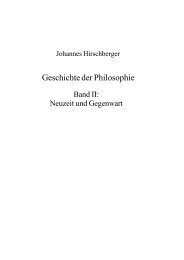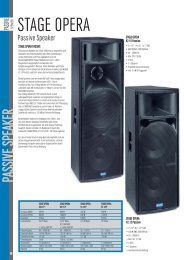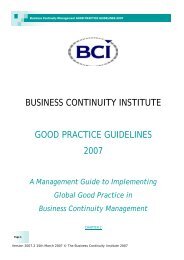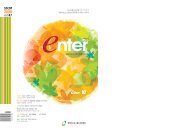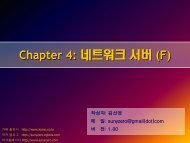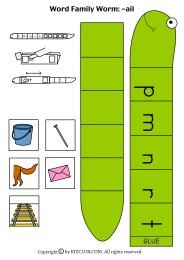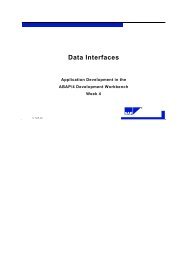- Page 2:
This page intentionally left blank
- Page 8:
Lambda-Calculus and Combinators, an
- Page 12:
To Carol, Goldie and Julie
- Page 16:
Contents vii 6C Equivalence of theo
- Page 20:
Preface The λ-calculus and combina
- Page 24:
Preface xi Last but of course not l
- Page 30:
2 The λ-calculus wrote f = λx . x
- Page 34:
4 The λ-calculus Notation 1.3 Capi
- Page 38:
6 The λ-calculus (a) lgh(a) = 1 fo
- Page 42:
8 The λ-calculus Remark 1.13 The p
- Page 46:
10 The λ-calculus (b) The relation
- Page 50:
12 The λ-calculus β-contractions
- Page 54:
14 The λ-calculus Before the theor
- Page 58:
16 The λ-calculus Exercise 1.36
- Page 62:
18 The λ-calculus Corollary 1.41.5
- Page 66:
20 The λ-calculus of the theory, a
- Page 70:
22 Combinatory logic S, a stronger
- Page 74:
24 Combinatory logic 2B Weak reduct
- Page 78:
26 Combinatory logic Exercise 2.16
- Page 82:
28 Combinatory logic Exercise 2.22
- Page 86:
30 Combinatory logic Theorem 2.32 (
- Page 90:
32 Combinatory logic (v) B(BS)Bxyzu
- Page 94:
34 The power of λ and CL term whos
- Page 98:
36 The power of λ and CL Remark Tu
- Page 102:
38 The power of λ and CL them a su
- Page 106:
40 The power of λ and CL 3D The qu
- Page 110:
42 The power of λ and CL X1 ≡ SI
- Page 114:
44 The power of λ and CL he publis
- Page 118:
46 The power of λ and CL ion-proce
- Page 122:
48 Computable functions to a β-nor
- Page 126:
50 Computable functions The first s
- Page 130:
52 Computable functions φ (k +1)x1
- Page 134:
54 Computable functions (r, s ≥ 0
- Page 138:
56 Computable functions 4C Recursiv
- Page 142:
58 Computable functions Definition
- Page 146:
60 Computable functions Theorem 4.2
- Page 150:
62 Computable functions where D ≡
- Page 154:
64 Undecidability gd(X), in honour
- Page 158:
66 Undecidability φ(j) =1 =⇒ F
- Page 162:
68 Undecidability Prove that the ge
- Page 166:
70 Formal theories or theorem of T
- Page 170:
72 Formal theories Remark 6.8 By th
- Page 174:
74 Formal theories conclusion, and
- Page 178:
7 Extensionality in λ-calculus 7A
- Page 182:
78 Extensionality in λ-calculus MQ
- Page 186:
80 Extensionality in λ-calculus Th
- Page 190:
8 Extensionality in combinatory log
- Page 194:
84 Extensionality in CL (c) S(KX)I
- Page 198:
86 Extensionality in CL Corollary 7
- Page 202:
88 Extensionality in CL other axiom
- Page 206:
90 Extensionality in CL (b) S(KX)(K
- Page 210:
9 Correspondence between λ and CL
- Page 214:
94 Correspondence between λ and CL
- Page 218:
96 Correspondence between λ and CL
- Page 222:
98 Correspondence between λ and CL
- Page 226:
100 Correspondence between λ and C
- Page 230:
102 Correspondence between λ and C
- Page 234:
104 Correspondence between λ and C
- Page 238:
106 Correspondence between λ and C
- Page 242:
108 Simple typing, Church-style (a)
- Page 246:
110 Simple typing, Church-style (b)
- Page 250:
112 Simple typing, Church-style Def
- Page 254:
114 Simple typing, Church-style so
- Page 258:
116 Simple typing, Church-style (a)
- Page 262:
118 Simple typing, Church-style The
- Page 266:
120 Simple typing, Curry-style in C
- Page 270:
122 Simple typing, Curry-style in C
- Page 274:
124 Simple typing, Curry-style in C
- Page 278:
126 Simple typing, Curry-style in C
- Page 282:
128 Simple typing, Curry-style in C
- Page 286:
130 Simple typing, Curry-style in C
- Page 290:
132 Simple typing, Curry-style in C
- Page 294:
134 Simple typing, Curry-style in C
- Page 298:
136 Simple typing, Curry-style in C
- Page 302:
138 Simple typing, Curry-style in C
- Page 306:
140 Simple typing, Curry-style in C
- Page 310:
142 Simple typing, Curry-style in C
- Page 314:
144 Simple typing, Curry-style in C
- Page 318:
146 Simple typing, Curry-style in C
- Page 322:
148 Simple typing, Curry-style in C
- Page 326:
150 Simple typing, Curry-style in C
- Page 330:
152 Simple typing, Curry-style in C
- Page 334:
154 Simple typing, Curry-style in C
- Page 338:
156 Simple typing, Curry-style in C
- Page 342:
158 Simple typing, Curry-style in C
- Page 346:
160 Simple typing, Curry-style in
- Page 350:
162 Simple typing, Curry-style in
- Page 354:
164 Simple typing, Curry-style in
- Page 358:
166 Simple typing, Curry-style in
- Page 362:
168 Simple typing, Curry-style in
- Page 366:
170 Simple typing, Curry-style in
- Page 370:
172 Simple typing, Curry-style in
- Page 374:
174 Simple typing, Curry-style in
- Page 378:
176 Simple typing, Curry-style in
- Page 382:
178 Simple typing, Curry-style in
- Page 386:
13 Generalizations of typing 13A In
- Page 390:
182 Generalizations of typing empha
- Page 394:
184 Generalizations of typing B3. I
- Page 398:
186 Generalizations of typing But w
- Page 402:
188 Generalizations of typing Defin
- Page 406:
190 Generalizations of typing (axio
- Page 410:
192 Generalizations of typing types
- Page 414:
194 Generalizations of typing A pse
- Page 418:
196 Generalizations of typing show.
- Page 422:
198 Generalizations of typing highe
- Page 426:
200 Generalizations of typing Here,
- Page 430:
202 Generalizations of typing In th
- Page 434:
204 Generalizations of typing Lemma
- Page 438:
206 Generalizations of typing Corol
- Page 442:
208 Generalizations of typing Deduc
- Page 446:
210 Generalizations of typing and,
- Page 450:
212 Generalizations of typing By Th
- Page 454:
214 Generalizations of typing This
- Page 458: 216 Generalizations of typing Howev
- Page 462: 218 Generalizations of typing a rul
- Page 466: 14 Models of CL 14A Applicative str
- Page 470: 222 Models of CL Definition 14.2 An
- Page 474: 224 Models of CL The definition of
- Page 478: 226 Models of CL The term model of
- Page 482: 228 Models of CL This might not be
- Page 486: 230 Models of λ S S φ(S) ′ ψ
- Page 490: 232 Models of λ M ≡ x and M ≡
- Page 494: 234 Models of λ [[λx.P ]]ρ = [[
- Page 498: 236 Models of λ Proof Exercise ⋆
- Page 502: 238 Models of λ this e works becau
- Page 506: 240 Models of λ Corollary 15.20.1
- Page 512: 15C General properties of λ-models
- Page 516: 15C General properties of λ-models
- Page 520: 16 Scott’s D∞ and other models
- Page 524: 16A C.p.o.s 249 λd ∈ D.φ(d) (
- Page 528: 16A C.p.o.s 251 computable function
- Page 532: 16B Continuous functions 253 Exerci
- Page 536: Proof Straightforward. 16B Continuo
- Page 540: 16C The construction of D∞ That i
- Page 544: 16C The construction of D∞ But φ
- Page 548: 16D Properties of D∞ 16D Basic pr
- Page 552: 16D Properties of D∞ Thus a0, a1,
- Page 556: 16D Properties of D∞ Lemma 16.47
- Page 560:
16E D∞ is a λ-model 267 16E D∞
- Page 564:
16E D∞ is a λ-model 269 = ψr
- Page 568:
16F Other models 271 16F Some other
- Page 572:
16F Other models 273 versions of P
- Page 576:
16F Other models 275 algebras to pr
- Page 580:
α-conversion 277 P ⊲1β (λx.(λ
- Page 584:
α-conversion 279 Lemma A1.7 For al
- Page 588:
α-conversion 281 Corollary A1.14.1
- Page 592:
A2A β-reduction 283 By Appendix A1
- Page 596:
A2A β-reduction 285 making [N/x]M,
- Page 600:
A2A β-reduction 287 Case 4: M ≡
- Page 604:
A2B Other reductions 289 where the
- Page 608:
A2B Other reductions 291 Next, defi
- Page 612:
Appendix A3 Strong normalization pr
- Page 616:
A3A SN for λ 295 Lemma A3.10 Let
- Page 620:
A3B SN for CLw 297 M ⋆ N ≡ (λx
- Page 624:
A3C SN for CLZ → KXY U1 ...Un ⊲
- Page 628:
A3C SN for CLZ → term Zτ m, and
- Page 632:
A3C SN for CLZ → Basis (m =0and m
- Page 636:
Appendix A4 Care of your pet combin
- Page 640:
Appendix A5 Answers to starred exer
- Page 644:
Answers to starred exercises 309 (
- Page 648:
Finally, for 1 ≤ i ≤ k, Answers
- Page 652:
Answers to starred exercises 313 as
- Page 656:
Answers to starred exercises 315 11
- Page 660:
(c) (d) 1 [x : σ →σ →τ] Answ
- Page 664:
Answers to starred exercises 319 Th
- Page 668:
Answers to starred exercises 321 To
- Page 674:
324 References [Bar84] H. P. Barend
- Page 678:
326 References [Chu41] A. Church. T
- Page 682:
328 References [HS80] J. R. Hindley
- Page 686:
330 References [ML75] P. Martin-Lö
- Page 690:
332 References [Sco76] D. S. Scott.
- Page 694:
0, numeral in typing system, 214 0,
- Page 698:
336 List of symbols λ-model, 231 a
- Page 702:
338 Index B, 21 in λ, 34 assigning
- Page 706:
340 Index extensionality axioms, se
- Page 710:
342 Index numerals abstract, 61 of
- Page 714:
344 Index standardization, 42 (star



